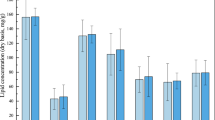Abstract
Municipal wastewater treatment plants in the USA produce over 6.2 × 106 t of dried sewage sludge every year. This microorganism-rich sludge is often landfilled or used as fertilizer. Recent restrictions on the use of sewage sludge, however, have resulted in increased disposal problems. Extraction of lipids from sludge yields an untapped source of cheap feedstock for biodiesel production. Solvents used for extraction in this study include n-hexane, methanol, acetone, and supercritical CO2. The gravimetric yield of oil was low for nonpolar solvents, but use of polar solvents gave a considerably increased yield; however, the percentage of saponifiable material was less. Extraction of lipids with a mixture of n-hexane, methanol, and acetone gave the largest conversion to biodiesel compared with other solvent systems, 4.41% based on total dry weight of sludge. In situ transesterification of dried sludge resulted in a yield of 6.23%. If a 10% dry weight yield of fatty acid methyl esters is assumed, the amount of biodiesel available for production in the USA is 1.4 × 106 m3/year. Outfitting 50% of municipal wastewater plants for lipid extraction and transesterification could result in enough biodiesel production to replace 0.5% of the national petroleum diesel demand (0.7 × 106 m3).


Similar content being viewed by others
References
Water Environment Federation (2002) Activated sludge MOP OM-9, 2nd edn. Water Environment Federation
Konar SK, Boocock D, Maom V, Liu J (1994) Fuels and chemicals from sewage sludge: 3. hydrocarbon liquids from the catalytic pyrolysis of sewage sludge lipids over activated alumina. Fuel 73:642–646
Ma F, Hanna M (1999) Biodiesel production: a review. Bioresour Technol 70:1–15
Loehr R, Navarra C Jr (1959) Grease removal at a municipal treatment facility. J WPCF 41:142–154
Rittmann B, McCarty P (2001) Environmental biotechnology: principles and applications. McGraw-Hill, New York
Nelson D, Cox M (2005) Principles of biochemistry. Freeman, San Francisco
The American Soybean Association (2005) Soy stats 2005. http://www.soystats.com/2005/Default-frames.htm
Christie W (2003) Lipid analysis. The Oily Press, Bridgwater
Hansen CM (2000) Hansen solubility parameters: a user’s handbook. CRC, Boca Raton
Croudace M, Ritz G (2003) Biodiesel/FAME analysis. Hydrocarb Eng 8:83–84
Acknowledgements
This work was supported by research grants from the Department of Energy (DE-FG36-04GO14251) and DOE EPSCOR (DE-FG02-00ER45830). Jessy Avelar and Keith Barlow provided laboratory assistance.
Author information
Authors and Affiliations
Corresponding author
About this article
Cite this article
Dufreche, S., Hernandez, R., French, T. et al. Extraction of Lipids from Municipal Wastewater Plant Microorganisms for Production of Biodiesel. J Amer Oil Chem Soc 84, 181–187 (2007). https://doi.org/10.1007/s11746-006-1022-4
Received:
Accepted:
Published:
Issue Date:
DOI: https://doi.org/10.1007/s11746-006-1022-4



